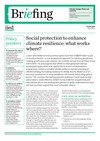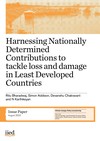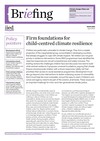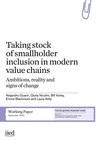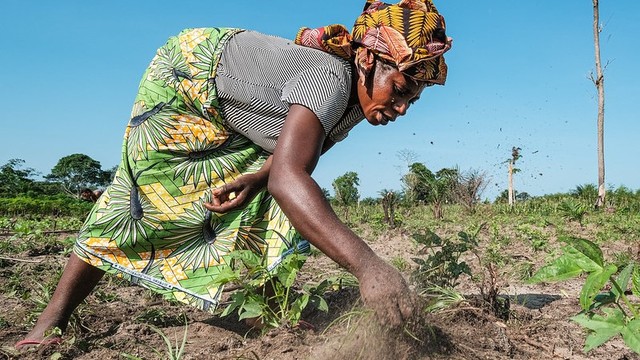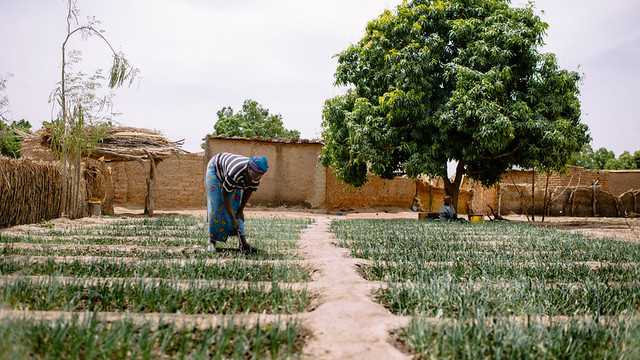IIED's best of 2022: publications
This year has seen some big moments for IIED, with a 50th birthday celebration, launches of major new research programmes and a new executive director in post. Through all of this, in 2022 we published more than 100 publications – a mix of issue papers, case studies, briefings and more.
The year began with a reflection of IIED’s last 50 years and finished with our participation at the Convention on Biological Diversity COP15. Everything that happened in between can be found in the publications we produced throughout the year.
Here are the top 10 most downloaded publications published in 2022 (plus one published in late 2021).
1. Social protection to enhance climate resilience: what works where?
Lower- and middle-income countries spend more than US$500 billion a year on social protection, a core development approach for reducing poverty and creating growth and social cohesion. As countries recover from and learn to live with COVID-19, and progress their efforts to meet global and national development goals, there is an opportunity to ensure social protection programmes contain a workable climate-resilience element, providing an effective strategy for building resilience to climate shocks.
Based on a full economic assessment of social assistance instruments and funding options across 122 countries, this briefing published in April presents evidence of what works to help policymakers create effective, resilient social protection programming and international donors and development partners to better understand how they can help countries support their most vulnerable citizens.
More about this work: IIED is supporting the world’s largest works-based social protection scheme, the Mahatma Gandhi National Rural Employment Guarantee Act (MGNREGA), to deliver climate resilience impacts for vulnerable rural communities in India.
As part of this work, we’ve explored how climate impacts, lack of social protection and marginalisation push households in two diverse communities in India towards distress migration. We provided recommendations on how to strengthen social protection programmes and informal job market regulations to support communities.
2. Climate change, migration and vulnerability to trafficking
Developed in partnership with PHIA Foundation and Aide et action, this 60-page working paper published in May is among the first to provide an empirical and compelling evidence base on the links between climate change, migration and trafficking, and unpacks the underlying drivers that should be targeted by policymakers to deal with this nexus.
This ground-breaking report provides the extent and impact of climate change on distress migration and human trafficking in two diverse areas impacted by slow onset and rapid onset climatic events.
More about this work: Together with Anti-Slavery International, IIED has been exploring how climate-driven migration and displacement puts people at an increased risk of trafficking and slavery. This report was further discussed at a webinar in May.
In a guest blog in June, Jasmine O'Connor, the chief executive of Anti-Slavery International, reflected on what needs to happen next.
3. Harnessing Nationally Determined Contributions to tackle loss and damage in least developed countries
Least developed countries (LDCs) are facing increasingly devastating impacts of climate change that are leading to loss and damage. As LDCs revise their climate action plans, known as Nationally Determined Contributions (NDCs), they should provide concrete evidence about loss and damage. This can help LDCs make the case for additional climate finance, technology and capacity-building support needed by them to tackle loss and damage.
This 50-page issue paper published in August analyses how LDCs are currently reporting loss and damage in their NDCs and National Adaptation Plans, identifies gaps or issues in coverage, and suggests a framework for addressing these gaps.
More about this work: Loss and damage is one of the most important issues for climate-vulnerable developing countries. IIED is working with LDCs, Small Island Developing States (SIDS) and representatives of vulnerable communities to develop a vision for practical action to address loss and damage caused by climate change.
Together with ICCCAD, we conducted a structured review of existing literature, a series of deliberative dialogues, and key informant interviews and consultations with representatives of affected communities and countries in LDCs and SIDS to assess the current evidence on the key features of loss and damage risks.
4. Firm foundations for child-centred climate resilience
Children are particularly vulnerable to climate change. They form a sizable proportion of the marginalised group, concentrated in developing countries, that already struggles to cope with climate impacts. Yet children are not given priority in resilience interventions. Some NGO programmes have identified the need, but responses are not yet comprehensive and widely inclusive.
This briefing published in April reviews the challenges children face and discusses how best to build child-centred resilience. It proposes universal foundations, arguing that climate finance should provide children with a shock-responsive ‘safety net’ that prioritises their access to social assistance programmes
Development must also go beyond crisis interventions to tackle underlying causes of vulnerability. And it must help the most vulnerable, not just the easy to reach. Children’s own voices and agency need to be part of the solution, at all levels. These issues are an important challenge for intra- and inter-generational climate justice.
More about this work: The climate crisis threatens children around the world. The United Nations Children’s Fund, UNICEF, estimates that one billion children are at ‘extremely high risk’ of the impacts of the climate crisis. IIED has undertaken research to assess the effectiveness of child-centred community-based adaptation: what works where, why – and what needs to be done differently?
5. Discomfort to discovery: exploring racism and anti-racism in development narratives
In 2020/21, IIED conducted an internal review to better understand whether and how dimensions of racism play out in the narratives that it writes and publishes. With this exercise, IIED focused on exploring how far its written content acknowledges or omits historic patterns of enslavement, colonial exploitation, present-day racism, and coloniality.
A framework developed identifies six dimensions of racism and coloniality that are dominant in aid and development storytelling: colour blindness, White gaze, saviourism, eurocentrism, neutrality, and exclusion. This 26-page evaluation published in April is relevant to the wider discourse on racism in the aid and sustainable development sectors, particularly for organisations considering how internal discourse and external communications influence strategy, values and culture.
The review succeeded in starting a valuable process of reflection; it also revealed that the narratives IIED uses to communicate its work do not sufficiently acknowledge how patterns of coloniality and racism impact on the sustainable development challenges that the organisation works on. This evaluation concludes with a roadmap for change that sets out the actions IIED will take based on the review.
More about this work: Reflecting on the review in a blog published in May, Natalie Lartey explored common challenges in tackling racial bias in the storytelling that underpins international development research and identifies opportunities for change.
6. Money where it matters for people, nature and climate: driving change through support for local level decision making over resources and finance
This 26-page report published ahead of the Stockholm+50 conference in May, provides practical recommendations for governments, multilateral development banks, global funds and intermediaries to drive change for people, nature and climate through locally-led action in the Decade of Action.
It explains the rationale for supporting locally-led action, and highlights trends and examples where the transition is under way. The report builds on many years of research by IIED, its partners and others on the importance of shifting decision-making power, financial flows and resources to the local level to support local priorities, needs, interests, rights, solutions and implementation.
While this report was written in the context of Stockholm+50, it remains relevant to other development, climate and nature meetings over the coming years, including international meetings of the UN Framework Convention on Climate Change and the Convention on Biological Diversity.
More about this work: The report from IIED, commissioned by Sida, was further discussed at a side event at Stockholm+50.
7. Taking stock of the Global Goal on Adaptation: from the Paris Agreement to the Glasgow-Sharm el-Sheikh work programme
The global goal on adaptation (GGA) was established in the Paris Agreement in 2015 in response to calls from developing countries to scale up action on adaptation. Many Parties expected work arising from the Paris Agreement to help operationalise the GGA, but progress was slow until COP26 in 2021, when the Glasgow- Sharm el-Sheik work programme (GlaSS) on the GGA was established.
This 30-page working paper published in April in English, French, Spanish and Brazilian Portuguese, describes what happened in the intervening years and proposes key questions for Parties to reflect on when engaging in the GlaSS to enhance adaptation action at the regional, national, sub-national and local levels.
More about this work: With the GlaSS work programme designed to advance action on the GGA, it’s crucial that civil society and local voices are incorporated to ensure the process is most inclusive. An IIED webinar in May explored how this could be achieved in practice.
8. Biocredits to finance nature and people: emerging lessons
Biodiversity is degrading at alarming rates, and people living in biodiversity-rich areas often bear the heaviest costs of biodiversity loss and inequitable conservation efforts. Biodiversity credits, or ‘biocredits’, are emerging as a tradeable unit of biodiversity that can incentivise nature conservation and restoration to benefit marginalised groups living with nature.
Demand for biocredits is growing among private investors, individuals and governments who want to invest in the conservation and restoration of biodiversity.
Based on a review of three existing biocredit methodologies and learning from the pitfalls of the carbon market, this 25-page toolkit published in December describes three challenges in designing and implementing an effective biocredit market: how to rigorously and equitably measure a unit of biodiversity; how to generate sufficient demand and sales of biocredits; and how the majority of the revenue from a biocredit scheme can be channelled back to Indigenous Peoples and local communities who will create biocredits for nature and climate outcomes.
More about this work: IIED is developing and disseminating knowledge and supporting country implementation for biodiversity credits, a novel approach to finance biodiversity conservation that mobilises resources to people living and working closest to biodiversity.
At an event in July, we explored the concept of biodiversity credits and its potential role to increase biodiversity while also making sure some of the world’s poorest people who live in biodiversity hotspots benefit.
9. Taking stock of smallholder inclusion in modern value chains: ambitions, reality and signs of change
This 40-page report published in September examines the promise and reality of including smallholders from developing countries in modern value chains as a path to sustainable development. Drawing on an extensive literature review and interviews with diverse stakeholders, we lay out the ambitions, expectations and assumptions hanging on smallholder inclusion with regard to income, gender equity and environmental sustainability.
We describe the gaps between expectation and reality, suggesting that inclusion – as conceptualised and implemented – is poorly suited to the complex challenges faced by farmers. We identify five signs of change in the discussion about smallholder inclusion, and reflect on what these might mean for its future.
More about this work: Small-scale farmers around the world have long sold their goods into both global and local markets. But over the last 20 years – reflecting a shift towards market-based approaches in international development – foreign aid agencies and NGOs have promoted the inclusion of smallholders in high-end, transnational value chains as a solution to challenges such as rural poverty, gender inequality and deforestation. Giulia Nicolini and Alejandro Guarín discussed the issues in a blog in September.
10. From what works to what will work. Integrating climate risks into sustainable development evaluation – a practical guide
Seven years after the adoption of the 2030 Agenda and the Paris Agreement, the world has changed dramatically. Yet methods and approaches for evaluating sustainable development interventions have remained largely unchanged.
Monitoring, evaluation and learning systems are failing to provide a basis for understanding how future sustainable development interventions can withstand the impacts of climate change. There is an urgent need for countries and the international community to move from looking at 'what works' to evaluating 'what will work'.
This 152-page guide published in July supports evaluation commissioners and evaluators across sectors to integrate different and uncertain climate futures into their evaluations to achieve better planning. We provide the context for the imperative to shift towards evaluations that assess 'what will work' in the face of an uncertain climate future. We outline six practical steps for designing evaluations that integrate climate risks and provide two practical working tools to support that process.
More about this work: Evaluation processes play a key role in national and global review systems for the Sustainable Development Goals (SDGs). In December 2021 a three-episode podcast series discussed the details and challenges of assessing progress against the SDGs.
Bonus: Linking sovereign debt to climate and nature outcomes. A guide for debt managers and environmental decision makers
As countries grapple with the triple crisis of debt, climate change and nature loss, compounded by the impacts of the COVID-19 pandemic, multiple innovative solutions in sustainable finance are beginning to gain traction. These innovations towards an inclusive green recovery offer substantial benefits for developing countries looking to increase their fiscal space, adapt to climate change, reduce their emissions and protect their natural environment.
This 36-page guide published in partnership with Potomac Group LLC, UNECA, UNESCWA and UNDP in November 2021 presents these innovations in an actionable plan that links sovereign debt to climate and nature outcomes. Seven practical steps outline ways for governments to complete a debt transaction linked to their sustainability goals for climate and nature.
Aimed primarily at debt managers and environmental decision makers, the guide also serves as an operational pathway for creditors, international institutions, and nongovernmental organisations to work together, using these emerging financing innovations to improve debt sustainability and increase climate and nature investment in the most climate-vulnerable and biodiversity-rich countries.
More about this work: Since its launch in November 2021, the guide has also been published in French and Arabic.
A COP27 Resilience Hub event in November 2022 saw a facilitated dialogue between debtor governments and creditors to reach political commitments for more large scale, programmatic debt swaps for climate and nature.
Our Publications Library is a repository, storing over two decades of outputs. Search over 7,000 individual records.
